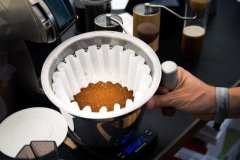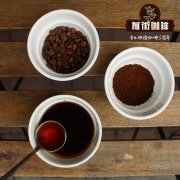Grindability and extraction Progress of hand-brewed Coffee

Professional coffee knowledge exchange more coffee bean information please follow the coffee workshop (Wechat official account cafe_style)
Earlier on, I saw a Taiwanese barista in Youtube explain why the coffee powder is thicker but the coffee brewed is more bitter. Contrary to the theory, I think it is worth thinking and discussing and tidying up the article. Sorry, I forgot to keep a record of the clip. You are welcome to supplement the video link.
In the film, the barista sifted the coffee powder with two degrees of grinding, divided it into three kinds of coarse and young degrees, and compared the cloth of the coarse young powder under the two degrees of grinding. In contrast, the group with rougher grinding degree, as expected, had more coarse particles, but there was no significant decrease in fine powder. The distribution can be understood as shown in the following figure:
The first group is called Reference Grind Size, the red part is fine powder, which is the main source of bitterness, green is medium thick, can be understood as contributing sweet part, yellow is coarse powder, the more this part, the more sour the coffee.
The second group was thicker (Coarser Grind Size), green medium powder decreased, instead of yellow coarse powder increased, red fine powder did not significantly decrease.
The taste of coffee requires a balance between sweet, sour and bitter. It can be inferred that, by comparison, the coffee made by the second group of coffee powder is more sour and less sweet than the first group, even though the objective bitterness (assuming it can be measured by machine) is about the same, but due to the lack of sweetness balance, the coffee of the second group will be more sour and bitter than the first group. This phenomenon runs counter to the theory of "adjusting roughness to acid, adjusting youth to thickening". The next step should be to explore the principle of fine powder formation, in order to explain why adjusting the degree of grinding can not reduce the amount of fine powder.
It can be seen that coffee brewing is true by taste, and the scientific nature of coffee lies in the experiment. The correct direction should be to refine the theory from the experiment and promote new fields based on the theory, rather than clinging to the theory and sticking to the rules.
Text: knowledge of Ken
END
Important Notice :
前街咖啡 FrontStreet Coffee has moved to new addredd:
FrontStreet Coffee Address: 315,Donghua East Road,GuangZhou
Tel:020 38364473
- Prev

[hand-brewing theory] the principle, tools and techniques of hand-brewing coffee
Professional coffee knowledge exchange more coffee bean information please follow the coffee workshop (Wechat official account cafe_style) this time to talk about the principle of hand-brewed coffee. It can be simply understood as "scouring" and "soaking". Scouring refers to stirring with tools such as water flow or stirring sticks to strengthen the friction between coffee powder and water, making the substances in coffee powder dissolve in water; while soaking
- Next

About the taste of coffee the description of the taste of coffee
Professional coffee knowledge exchange more coffee bean information Please follow the coffee workshop (Wechat official account cafe_style) when you take a sip of coffee into your throat, in addition to bitter, what else do you taste? Don't rush to add sugar, cream, or milk. Good coffee is worth waking up all your taste buds and savoring its original taste. To taste good coffee is not only to use the taste of the tongue.
Related
- Beginners will see the "Coffee pull flower" guide!
- What is the difference between ice blog purified milk and ordinary milk coffee?
- Why is the Philippines the largest producer of crops in Liberia?
- For coffee extraction, should the fine powder be retained?
- How does extracted espresso fill pressed powder? How much strength does it take to press the powder?
- How to make jasmine cold extract coffee? Is the jasmine + latte good?
- Will this little toy really make the coffee taste better? How does Lily Drip affect coffee extraction?
- Will the action of slapping the filter cup also affect coffee extraction?
- What's the difference between powder-to-water ratio and powder-to-liquid ratio?
- What is the Ethiopian local species? What does it have to do with Heirloom native species?

